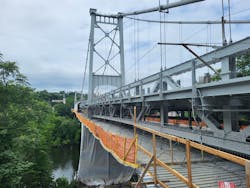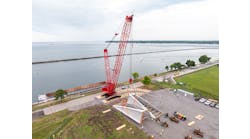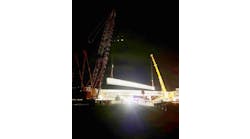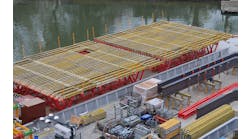By Blaise Blabac and Dan McCaffrey, Contributing Authors
Regardless of the type of bridge, maintenance is crucial. However, suspension and certain arch bridges require consistent attention to their hangers or suspenders, which bear the weight of the deck and traffic.
These components, often exposed and susceptible to deterioration from factors like age, fatigue, and corrosion, may necessitate replacement despite their initial design safety factors.
Hanger and suspender replacement projects are a significant undertaking, and they are essential to ensuring the safety of our bridges.
Understanding Hanger and Suspender Systems
Hangers and suspenders are the vertical cables that connect the bridge deck/superstructure to the main cables or to the arch ribs. They are typically made of high-strength galvanized steel wire ropes or strands, with the number and spacing of cables dependent upon the design of the bridge.
Socketed ends anchor the wires and provide the structural connection. Sockets, cast or machined, contain a hollow core for the cable, and with wires spread within, it is filled with molten zinc. Various socket types exist for different connections, like anchor sockets, adjustable threaded sockets, or open sockets for pinned ends.
On suspension bridges, the cables, known as suspender ropes, typically consist of a single rope passing over the main cable, resting in a groove, and then descending to an anchor point near the deck. Wire rope is chosen for its flexibility, accommodating the cable band's small radius.
Cable bands, composed of two halves bolted together, grip the main cable, generating necessary friction to manage vertical loads, especially on steep sections. Occasionally, two suspender ropes per cable band are employed to enhance load capacity while maintaining flexibility using a smaller diameter rope.
Arch bridge cables, called hangers, are usually straight elements between connection points, avoiding the need for a radius. They're individually socketed at the arch and deck levels. These hangers use bridge strand, denser with wires than wire rope, making it stronger and stiffer at the same diameter. Modern suspension bridges also opt for strand due to its benefits, using open socket connections on the cable band instead of wrapping around the cable.
The design and manufacture of wire ropes and strands is a highly standardized industry. It is important to work closely with manufacturers when selecting the right replacement item for the project, which needs to consider rope diameter, coating thickness, and wire strength.
Issues that Drive Replacement Needs
Corrosion drives the need for hanger and suspender cable replacement. The cables are often within the splash zone, facing weather and salt-laden splash spray. Depending on the socket orientation, for vertical cable elements, the top socket area where cables enter is especially vulnerable to water pooling and severe corrosion.
Material loss in cable sections can lead to higher stress and fatigue cracks. Without corrosion, however, fatigue is rarely an issue. Originally designed with a safety factor of three (or higher), these cables usually have extra capacity. However, corrosion coupled with higher traffic loads can reduce the desired safety factor.
To determine the remaining capacity of a suspender/hanger, accurate capacity assessment involves removing a suspender for failure testing and replacing it with a new rope, causing minimal bridge traffic disruption. While non-destructive testing methods exist, like magnetostriction, they struggle to assess sections near sockets or support points where deterioration typically occurs.
Replacing corroded systems ensures load capacity and safety. For aging structures, it’s wise to establish a routine involving multiple cable removals for destructive testing. Regular tests provide an accurate element condition overview, enabling proactive planning for future maintenance.
Challenges Faced During Hanger and Suspender Replacement Projects
When approaching a hanger or suspender replacement project, there are many challenges that should be considered.
Evaluate whether temporary support is needed: For a typical suspension bridge with a stiffening truss, the truss may be capable of distributing panel point load to nearby points during suspender replacement. All aspects of the alternate load path, including transverse elements and connections, must be considered, notably adjacent suspenders.
Since the project likely addresses corroded cables, expecting adjacent cables to carry extra loads should be viewed with caution. For flexible floor systems, like tie girders in tied arches, temporary support is often necessary.
Connection details: Early selection of socket size and design is important as their geometry influences connection details. Certain sockets permit length modification via shims or threads, unlike pinned ends. The need for adjustability will be based on a variety of factors, such as availability of original shop drawings, live loads during construction, and roadway profile tolerances.
Geometry versus load control: When replacing hangers and suspenders, a choice arises between precise geometry and closer loads to the target. Balancing both is unfeasible. Load control reveals displacing load upfront, though initial lift-off varies, demanding re-evaluation.
Bridges utilizing suspenders or hangers were generally erected to a theoretical geometry of the suspenders rather than setting them to a precise load. Geometry control therefore relies on precise measurements on long elements measured at great heights. The presence of live loads during erection add complexity, potentially requiring extra adjustments. Regardless of the choice, understanding challenges and allowing tolerances is vital.
Temporary works: Replacing hangers and suspenders involves reducing tension on existing load and install new parts, using temporary cables, beams, and clamps. Each bridge offers unique temporary setup choices, demanding engineering creativity. Key factors are geometry, efficiency, speed, and risk reduction, with the aim of a reliable, swift, and secure process.
Friction clamps can be used to grip cables, especially if sockets lack temporary attachment options. They usually consist of two grooved halves bolted onto cables, with pricier hydraulic grips available. When using friction clamps with new cables, it is important to detail the clamps to reduce the potential for damaging the new cables.
Wurts Street Bridge
Opened in 1921 and known as the “Wurts Street Bridge,” the Kingston–Port Ewen Suspension Bridge connects Kingston, N.Y. with Port Ewen.
As part of the 2008 main cable investigation, two suspender ropes were removed from the bridge and tested in a laboratory. A testament to their quality, even at almost 90 years old, their ultimate strength exceeded the original fabrication's minimum.
Their remarkable condition was due to the use of an open socket connection—relatively unusual for a bridge of this era but common practice in modern structures—which is free-draining and does not tend to trap water and debris against the wire rope the way anchor sockets often do.
Unfortunately, the truss connection hardware (adjustable U-bolts) suffered heavy corrosion and required replacement. From a cost and effort perspective, it was only logical to replace the ropes along with the hardware.
All 114 suspender ropes on the bridge are being replaced as part of this project. The ropes are being replaced in-kind (including open bridge sockets), but the connection hardware is being replaced with a one-piece weldment that is not adjustable.
It was not feasible to replace the existing connection hardware in-kind. The existing U-bolts are a non-standard radius and replacing rivets with bolts was not feasible due to geometry constraints.
Originally, adjustable suspender connections were necessary because of the non-uniform modulus of elasticity in wire rope load cycles, given that wire rope prestressing had not been invented when the bridge was built.
However, since maintaining the as-built bridge profile was a priority and no changes in the roadway profile were required, a fixed connection became feasible. Unfortunately, the absence of record plans necessitated precise field measurements using LiDAR and steel tape, with calculated values applied for lengths over the cable bands due to their unusual geometry.
Suspenders are replaced without temporary support using the sturdy truss spanning two panels, carrying construction loads of 1,000-pounds per linear foot and a 20-ton concentrated load. The same system is used for de-tensioning the original ropes and tensioning the replacement ropes.
The sockets are pinned to the weldment prior to tensioning. While the suspender is removed, the cable band groove is cleaned, and a bedding of zinc paste is applied to displace any moisture at the interface between the rope and cable band casting.
In the realm of modern infrastructure, where bridges stand as essential conduits of connectivity and commerce, the importance of hanger and suspender cables acts as a vital safeguard. As the lifelines of suspension bridges, their resilience against the elements and their ability to safely bear immense loads over long periods of time allow them to play a significant role in the long-term safety and sustainability of our bridges and communities. R&B



